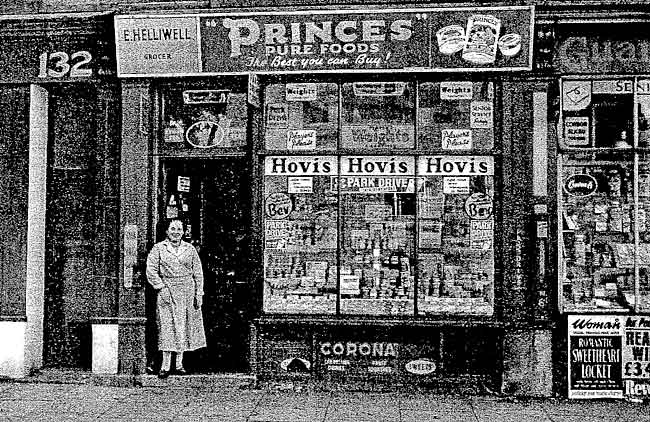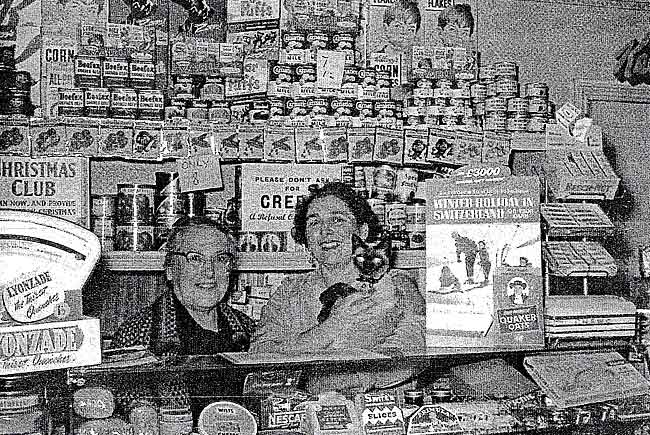< Previous
THE LOCAL SHOP
By Stephen Best

OLD SHOPS OF THE NEIGHBOURHOOD have frequently figured in past issues of Sneinton Magazine. One which has not previously been mentioned here, however, is Helliwell’s grocers, of 130 Sneinton Road, and I am indebted to Mrs Joan Salerno for the loan of the accompanying photographs of it. The shop stood a couple of doors away from the comer of Notintone Street; its site is now marked by housing opposite the row of modern shops at the top of Sneinton Road.
No. 130 had enjoyed a varied history. For some twenty years from the early 1880s it was Wardle’s boot and shoe repairers, but by 1907 was the address of Arthur Smith’s undertaker’s business. Smith did not stay here long, however, and a year or so the shop was home to a hardware dealer named William Grain. By 1913 it had undergone yet another change of use, which saw it turned into a gentlemen’s hairdressers. This was run by Samuel Edward Woodward who had previously plied his trade just over the road at 115 Sneinton Road, near the comer of Ten Feet Street.
The undertaking trade, however, proved tenacious, and returned to the premises for a much longer spell than before. George Birch, joiner and undertaker, was in business here from the early part of the Great War until the second half of the 1950s, and might have been expected to see out the life of the old building.
The shop, though, found an entirely new role in its final decade. From being an address where Sneinton people had been shod or shorn, or had arranged for their relatives to be buried, 130 Sneinton Road became involved in the business of feeding them.
Helliwell’s opened, as already mentioned, in the 1950s when the family moved to Sneinton from Lenton. In the photographs here we see Mrs Ebe Helliwell outside her shop in September 1959, and behind the counter with her mother in August 1960. Mrs Helliwell was bom in Genoa, Italy, of Swiss parentage, and had come to England after the close of the Second World War.
Joan Salerno recalls a happy life in Sneinton Road, when as a girl she lived behind and above the shop. She remembers her close neighbours Smiths the chemists, and the almost-legendary Billy Glossop, whose greengrocery was next-door-but-one from her mother’s shop. Joan also speaks with affection of the Rev. John Tyson, then in the early years of his long term as vicar of Sneinton.
Examination of the original prints through a magnifying glass reveals a wealth of detail. Helliwell’s shop window display appears immaculate, and one could only wish that a close-up of it had also been taken. At this remove in time, it is a surprise that Player’s Weights were still on the market - though no longer sold by weight in 1959. The post-war hot drink Bev, which to this writer tasted awful, evidently continued to attract purchasers then. (To the makers of Bev, and to any former fans of it, I offer unreserved apologies.)
Among other familiar brands advertised outside the shop are Hovis Bread: Corona Soft Drinks: Lyons Tea: Senior Service, Park Drive, and Bachelor cigarettes. Princes Canned Foods have pride of place above the window with the big signboard.
Sneaking a look at the newsagent next-door (I think it was still King’s then?) the eye is caught by a placard announcing that ‘Woman’ magazine was currently including an offer for a ‘Romantic sweetheart locket.’ The adjacent advertisement, by the way, is almost certainly promoting what in those days seemed the slightly risque weekly ‘Reveille.’
Over the newsagent’s window can be seen an advert for the ‘Guardian Journal,’ a reminder that Nottingham had a morning daily paper until 1973. Indeed, only six years before the date of this photograph there were four dailies published in the city. The ‘Nottingham Journal,’ one of the morning papers, and the oldest of the four, ceased publication in 1953, followed a decade later by the ‘Evening News.’ Ten years after this, the last issue of the ‘Guardian Journal’ was printed - 1953, 1963, and 1973: all were bad years for the press in Nottingham.
The newsagent’s window seems to be largely stocked with jars of sweets, and also visible are adverts for Craven A cigarettes and Condor Sliced tobacco.
The interior view of Helliwell’s shop reveals the orderly arrangement of goods that the window has led us to expect. And we find the shop cat, almost omnipresent at the time, but nowadays no doubt severely frowned on by food inspectors.
Mrs Helliwell was accustomed to sell goods by weight; the scales which may just be glimpsed through the shop doorway are on the counter. The traditional injunction not to ask for credit, lest 'A refusal may offend,' is prominently displayed, as it was in so many local shops of the day. Near it is a card reminding customers to save through Helliwell’s Christmas Club.
Prominently on show are details of a Quaker Oats competition which promised a winter holiday in Switzerland, or £300 cash. This was about eight months’ salary for me at the time, and a sum to be gasped at, and heartily coveted.
Of the goods on sale Kellogg’s Com Flakes, Sugar Puffs, Carnation evaporated milk, and Nescafe remain familiar enough today, and also clearly remembered are Primula cheese spread and Picnic Bars. Am I alone, though, in having forgotten Beefox Corned Beef, Wilts Cheese Spread, Lyonzade Thirst Quenchers (only three-halfpence each,) and Swift’s Processed Cheese Slices?
In the 1950s there were about a dozen manufacturing confectioners in Nottingham. The best known of these, perhaps, were Barnett’s, Derbyshire's, and Watmough‘s. A jar of sweets made by the last-named may be glimpsed just under the scales. Watmough’s factory was in Paddock Street, off Greyfriar Gate, both of them now vanished thoroughfares, swallowed up by the Broad Marsh Centre. Plenty of local people will still remember Watmough’s retail shops, the most prominent of which was on the comer of South Sherwood Street, built into the end of the Theatre Royal frontage.
And, by the look of the display on the right, Sneinton must have been teeming with gum chewers in 1960; there is a three-decker rack full of the stuff visible here. (Did we not notice litter so much in those days, or used people to wrap the discarded gum up and put it in litter bins? Certainly I do not remember pavements disfigured by trodden-in gum as they are today.) The bottom tray is for chews. Trebor used to market them for a penny, and very bad for our teeth they must have been. But delicious.
And under the counter, in front of the gum, is a Smoker’s Set, complete with a picture of a curly pipe on the box - the only sign of the tobacco trade to be seen inside the shop.
If any readers of Sneinton Magazine recall shopping at Helliwell ’s, or at one of the nearby shops in Sneinton Road, the editor would be glad to hear from them, for possible publication. Once again I thank my neighbour Joan for making available these fascinating photographs. Although they record what were 45 years ago everyday scenes, they are now priceless social documents. SB

< Previous
